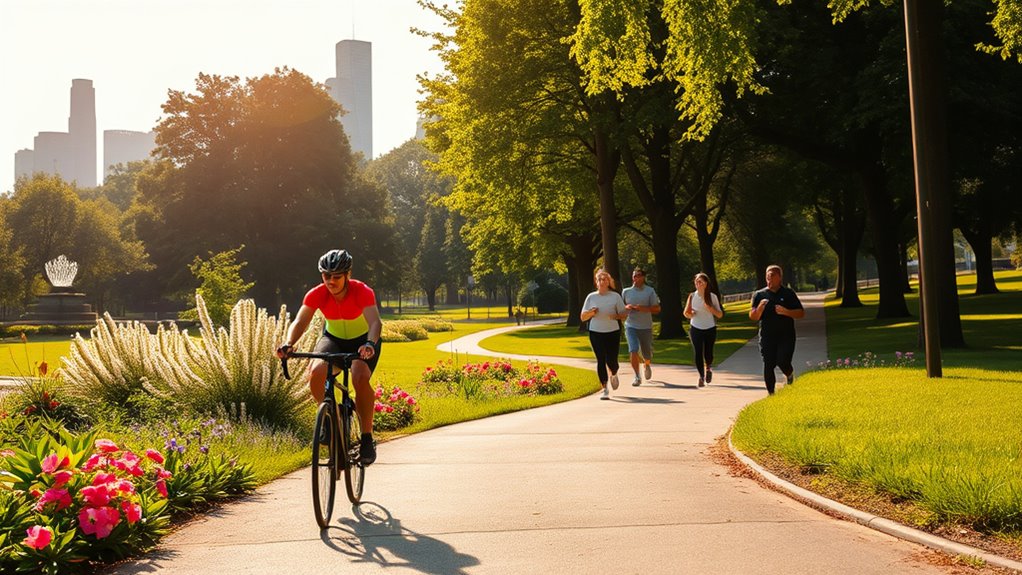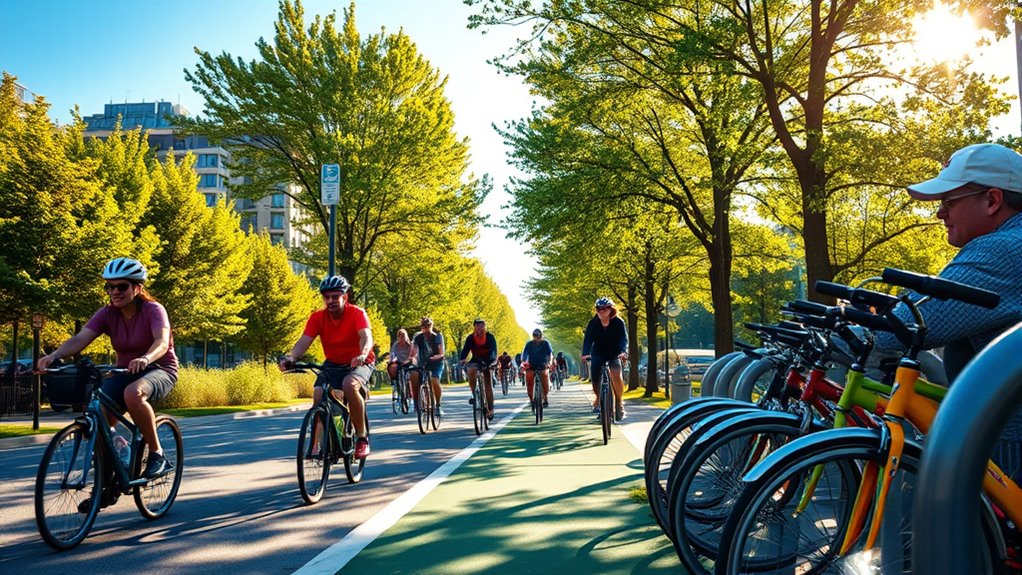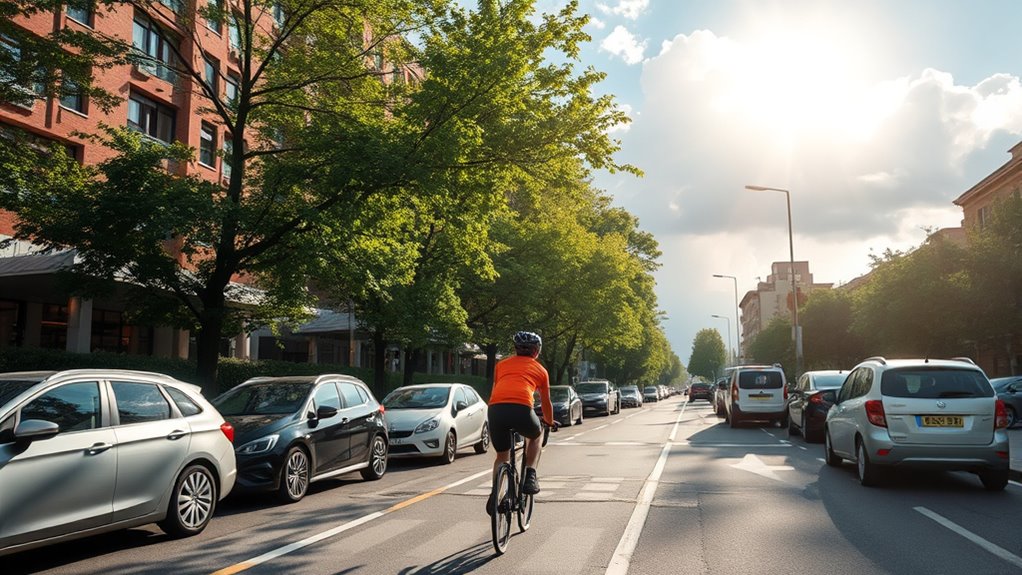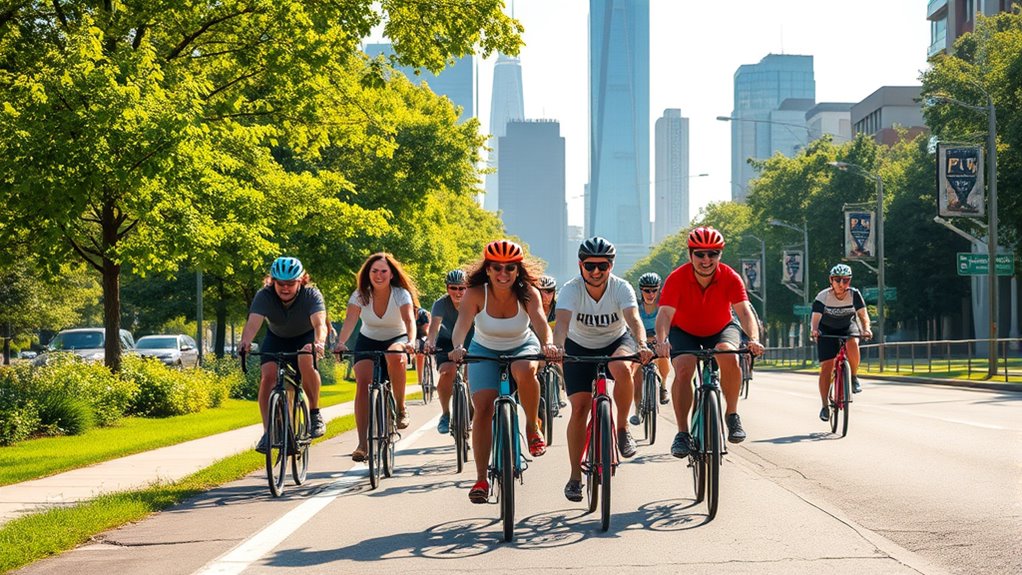Bicycle commuting offers impressive health, environmental, and financial benefits. It can lower your all-cause mortality risk by 47% and reduce healthcare costs while also slashing your transportation expenses. Cycling decreases carbon emissions, helping improve air quality and promotes sustainable cities. Plus, engaging in community cycling fosters connections and friendships. With supportive infrastructure and policy backing, the future of cycling looks bright. There’s much more to explore about how it can enhance your life.
Key Takeaways
- Bicycle commuting lowers all-cause mortality risk by 47% and significantly reduces risks of cardiovascular disease and cancer.
- Cycling decreases carbon emissions, improves urban air quality, and supports sustainable transportation infrastructure.
- Commuting by bike can save around $837 annually on fuel and parking, enhancing financial freedom.
- Regular cycling fosters community connections, promotes inclusivity, and strengthens social ties among cyclists.
- Effective infrastructure and policies, like dedicated bike lanes and subsidies, encourage safe cycling and boost commuter adoption.
Health Benefits of Bicycle Commuting

When you choose bicycle commuting, you’re not just making an eco-friendly choice; you’re also investing in your health.
Cycling notably lowers your risk of all-cause mortality, reducing it by 47%. You’ll notice a 24% lower risk of cardiovascular disease hospitalization and a remarkable 51% decreased risk of cancer death. Additionally, replacing short trips with biking can save approximately $3.8 billion annually from reduced mortality and healthcare costs. Incorporating regular exercise into your routine can further enhance these health benefits. Moreover, maintaining a healthy lifestyle through activities like cycling can lead to better overall financial health, as reduced healthcare costs contribute to a more stable budget. Chia seeds, for example, are high in fiber, which promotes satiety and can support weight loss efforts.
Cycling significantly reduces all-cause mortality risk by 47%, lowers cardiovascular hospitalization risk by 24%, and cuts cancer death risk by 51%.
Beyond physical benefits, cycling boosts your mental health, cutting the likelihood of mental health-related prescriptions by 20%. Additionally, it helps manage obesity and lowers your risk of type 2 diabetes. Engaging in physical activities like cycling promotes the release of endorphins, which can improve mood and overall mental well-being.
You’ll enjoy improved cardiovascular fitness, enhanced muscle strength, and better joint mobility, all while decreasing body fat levels.
Ultimately, cycling fosters a healthier lifestyle that promotes longevity and well-being.
Environmental Advantages of Cycling

Cycling not only enhances your health but also offers significant environmental advantages that benefit everyone.
By choosing to bike instead of drive, you actively reduce carbon emissions and lower greenhouse gas output, contributing to cleaner air and a healthier environment. Your bike rides help decrease air pollutants, improving urban air quality and making cities more livable. Additionally, cycling promotes renewable energy technologies, as the shift towards biking can encourage communities to invest in more sustainable transportation infrastructure. Furthermore, embracing cycling can lead to a greater demand for multi-functional gear that supports eco-friendly commuting options. As cities adopt solar-powered bike lanes, the integration of renewable energy solutions into cycling infrastructure further enhances sustainability.
Plus, cycling is energy-efficient, relying on human power rather than fossil fuels. With less reliance on cars, you also help conserve road space and promote sustainable urban planning. Furthermore, e-bikes produce zero tailpipe emissions, making them an even cleaner alternative for short trips.
By embracing cycling, you support a quieter, more peaceful community while preserving natural habitats and reducing waste.
Ultimately, your choice to cycle fosters a greener, more sustainable future for everyone.
Cost Savings Associated With Bicycle Use

Opting for a bicycle instead of a car can lead to significant cost savings in your daily life. By swapping car trips for e-bike rides, you could save around $837 annually on fuel and parking.
In fact, total potential savings from using an e-bike can exceed $6,000 when you factor in ownership and operating costs. Cycling eliminates fuel expenses and reduces maintenance needs, further boosting your budget. This is especially true since e-bike ownership costs are significantly lower than those of cars. Additionally, engaging in regular cycling can contribute to healthcare cost reductions by improving your overall fitness, which enhances your financial well-being. Moreover, just as Ford tuning can optimize performance and efficiency, cycling optimizes your budget by reducing transportation costs. Furthermore, credit card debt can be alleviated by reallocating funds saved from transportation.
In urban areas, you often avoid hefty parking fees, making cycling even more financially appealing. With these savings, you can increase your disposable income, allowing for investments or debt repayment.
Plus, regular cycling may lower healthcare costs by improving your fitness, giving you even more financial freedom.
Social Benefits of Cycling in Communities

As you embrace cycling, you’ll discover a world of social benefits that extend far beyond the ride itself.
Cycling brings people together, fostering connections and building bonds among participants. You can join inclusive cycling communities that welcome cyclists of all ages and skill levels, participating in group rides and events that encourage social interaction. The joy of riding together allows participants to experience an enhanced sense of unity and shared purpose, making each ride more enjoyable. Additionally, cycling encourages higher productivity levels as it promotes physical activity, which can lead to improved mental health and focus. Engaging in community-focused activities can also create a sense of belonging and support among neighbors. Shared experiences through cycling journeys can strengthen friendships and deepen connections within the community.
These gatherings allow for knowledge sharing and mutual support, enhancing your cycling experience. Furthermore, social media and online platforms help you stay engaged with fellow cyclists, boosting community ties.
The Role of Infrastructure in Promoting Cycling

When it comes to promoting cycling, effective infrastructure plays a crucial role in creating safe and inviting environments for riders. Protected bike lanes separate you from traffic, greatly reducing injury rates. Traffic calming measures, like narrower roads, slow down drivers, enhancing safety for everyone. You’ll find that strategically placed bike paths encourage you to choose cycling over driving by avoiding heavy traffic and minimizing distance. Plus, building these paths is often cheaper than new roadways, delivering cost savings. Communities with strong cycling infrastructure see economic growth, increased local business sales, and improved public health outcomes. Investment in bike lanes fosters economic growth by attracting residents and visitors who prefer outdoor recreation options. Additionally, diverse tent camping locations can be easily accessed by cyclists, allowing for unique outdoor experiences. Furthermore, integrating backyard greenhouses in community gardens can enhance local food production and promote sustainable living. As ridership increases, so does the overall quality of life, making cycling a smart choice for you and your community. Moreover, the emphasis on data-driven marketing strategies can help promote cycling initiatives effectively within the community.
Policy Support for Bicycle Commuting

While effective policies can greatly boost bicycle commuting, many communities still lack the necessary support to make cycling a viable option.
Legislative efforts, like the Bicycle Commuter Act of 2023, aim to expand tax exclusions for bicycle commuting benefits, while the U.S. Department of Transportation offers a $20 monthly subsidy for cyclists. Additionally, promoting tax advantages for commuting benefits can further incentivize cycling as an alternative transport method.
Legislative initiatives, including the Bicycle Commuter Act of 2023, seek to enhance tax benefits and provide financial support for cyclists.
However, the 2017 Tax Cuts and Jobs Act suspended non-taxable benefits until 2026, complicating existing subsidies. This highlights the need for improved financial aid sources that can support sustainable commuting options.
Reimbursement programs, such as the Bicycle Transportation Reimbursement Program, encourage sustainable commuting.
In addition, Executive Order 13990 promotes initiatives like the Active Bicycle Commuting Subsidy to safeguard public health and the environment. Mediation services can also play a role in resolving disputes related to bicycle infrastructure development and community support.
Challenges and Risks of Cycling

Traffic safety concerns are a major deterrent; you might worry about hazards like car doors opening unexpectedly or maneuvering around rails and trolley lines. Maintaining a safe distance from parked vehicles can help mitigate the risk of sudden door openings. Additionally, understanding camping safety gear like helmets and reflective clothing can enhance your visibility and protection while cycling. Regular maintenance of your bicycle, such as checking the toilet components, can prevent unexpected breakdowns that pose risks while riding.
Weather conditions can further complicate things, with rain making roads slippery and fog obscuring hazards.
You’ll also face road obstacles, such as potholes and debris, that can lead to falls.
Additionally, exposure to pollution and the risk of traffic accidents in dense areas can weigh on your mind.
Finally, perceived risks and social stigma might keep you from embracing cycling as a viable transportation choice.
Strategies to Encourage Bicycle Commuting

To encourage more people to contemplate bicycle commuting, it’s essential to implement a variety of strategies that address safety, accessibility, and community support.
First, developing dedicated bike lanes and providing clear signage can greatly improve safety for cyclists. Adding bike racks at workplaces and public areas makes cycling more accessible. Investment in proper bike infrastructure is crucial to support the growing number of cyclists.
You can also promote bike-sharing programs to increase participation. Community engagement is important; organize cycling events and workshops to educate and foster a supportive culture.
Partner with local businesses to offer incentives for cyclists. Highlight the economic and health benefits, emphasizing cost savings and improved well-being.
Finally, advocate for policies that protect cyclists and encourage urban planning that includes cycling infrastructure. Together, these strategies can transform commuting habits.
The Future of Bicycle Commuting in Urban Areas

As urban areas evolve, the future of bicycle commuting looks promising, driven by a combination of technological advancements and increasing environmental awareness.
E-bikes are becoming popular for their convenience, bridging the gap between cycling and motorized transport. Cities are investing in dedicated bike lanes and smart traffic systems, enhancing safety and efficiency. With the rapid growth of electric bikes transforming urban cycling, more commuters are likely to embrace this eco-friendly mode of transportation.
E-bikes are revolutionizing commuting, as cities enhance safety with dedicated lanes and smart traffic systems.
With cycling’s role in reducing carbon emissions, you contribute to cleaner environments and better health outcomes. Bike-sharing programs and GPS technology offer seamless travel options.
As urban planning prioritizes bike-friendly designs, you’ll find more protected lanes and car-free zones.
Despite challenges, the growth of the cycling market and its economic benefits signal a bright future for bicycle commuting in urban areas.
Frequently Asked Questions
How Can I Stay Safe While Cycling in Traffic?
To stay safe while cycling in traffic, always follow road rules and ride in the direction of traffic.
Wear bright, reflective clothing and use lights in low-light conditions. Signal your turns and lane changes to enhance visibility.
Keep a safe distance from parked cars to avoid door accidents, and be cautious at intersections.
Regularly maintain your bike and stay alert to your surroundings. Avoid distractions, like headphones, to focus on the road.
What Types of Bicycles Are Best for Commuting?
When choosing a bicycle for commuting, consider your needs.
Hybrid bikes offer versatility for diverse terrains, while electric bikes provide assistance for longer distances or hilly routes.
If you need to carry loads, cargo bikes are your best bet.
For tight storage, folding bikes are compact and convenient.
Look for features like fenders, lights, and comfortable seating to enhance your ride.
Each type has unique benefits tailored to different commuting styles.
How Do I Maintain My Bike for Daily Use?
To maintain your bike for daily use, start with essential pre-ride checks like tire pressure, chain lubrication, and brake inspection.
Regularly clean your drivetrain and tighten bolts to guarantee everything’s secure.
Schedule a professional tune-up annually, and replace worn parts as needed.
Keep an eye on cable wear and align your wheels for better control.
Finally, equip yourself with tools like a bike multi-tool and tire levers for quick fixes.
What Gear Do I Need for Comfortable Cycling?
For comfortable cycling, you’ll need a few essentials.
You’ll want a waterproof jacket for rainy days, padded shorts for a smoother ride, and gloves for better grip.
Don’t forget cycling shoes that support your feet. A wicking jersey keeps you dry, while a good helmet guarantees safety.
Add bike lights for visibility and a reliable lock for security.
With this gear, you’ll enjoy your rides while staying safe and comfortable!
Can I Cycle in Inclement Weather Safely?
Yes, you can cycle in inclement weather safely with the right preparation.
Check the forecast before heading out, and choose well-maintained routes. Equip yourself with waterproof gear and guarantee your bike’s lights are functional for visibility.
Slow down to react to hazards and avoid slippery surfaces. Practice proper braking techniques and take wide turns for better control.
With these precautions, you can enjoy your ride while staying safe in challenging conditions.
Conclusion
In the tapestry of urban life, bicycle commuting weaves together threads of health, sustainability, and community. By choosing to ride, you’re not just pedaling toward work; you’re forging a path toward a cleaner environment and a vibrant social fabric. Embracing cycling symbolizes a commitment to personal well-being and collective progress. As cities evolve, let your bike be the compass guiding you toward a future where every ride is a step toward a healthier, more connected world.










